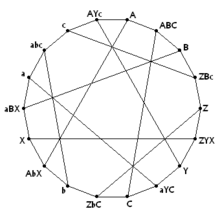
Back Inzidenzgraph German Grafo de Levi Spanish Graphe de Levi French Illeszkedési gráf Hungarian Граф Леви Russian Граф Леві Ukrainian
| Levi graph | |
|---|---|
 The Pappus graph, a Levi graph with 18 vertices formed from the Pappus configuration. Vertices labeled with single letters correspond to points in the configuration; vertices labeled with three letters correspond to lines through three points. | |
| Girth | ≥ 6 |
| Table of graphs and parameters | |
In combinatorial mathematics, a Levi graph or incidence graph is a bipartite graph associated with an incidence structure.[1][2] From a collection of points and lines in an incidence geometry or a projective configuration, we form a graph with one vertex per point, one vertex per line, and an edge for every incidence between a point and a line. They are named for Friedrich Wilhelm Levi, who wrote about them in 1942.[1][3]
The Levi graph of a system of points and lines usually has girth at least six: Any 4-cycles would correspond to two lines through the same two points. Conversely any bipartite graph with girth at least six can be viewed as the Levi graph of an abstract incidence structure.[1] Levi graphs of configurations are biregular, and every biregular graph with girth at least six can be viewed as the Levi graph of an abstract configuration.[4]
Levi graphs may also be defined for other types of incidence structure, such as the incidences between points and planes in Euclidean space. For every Levi graph, there is an equivalent hypergraph, and vice versa.
- ^ a b c Grünbaum, Branko (2006), "Configurations of points and lines", The Coxeter Legacy, Providence, RI: American Mathematical Society, pp. 179–225, MR 2209028. See in particular p. 181.
- ^ Polster, Burkard (1998), A Geometrical Picture Book, Universitext, New York: Springer-Verlag, p. 5, doi:10.1007/978-1-4419-8526-2, ISBN 0-387-98437-2, MR 1640615.
- ^ Levi, F. W. (1942), Finite Geometrical Systems, Calcutta: University of Calcutta, MR 0006834.
- ^ Gropp, Harald (2007), "VI.7 Configurations", in Colbourn, Charles J.; Dinitz, Jeffrey H. (eds.), Handbook of combinatorial designs, Discrete Mathematics and its Applications (Boca Raton) (Second ed.), Chapman & Hall/CRC, Boca Raton, Florida, pp. 353–355.